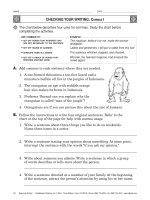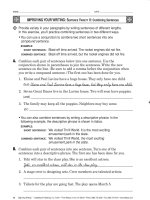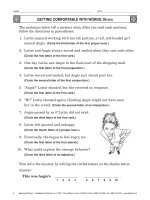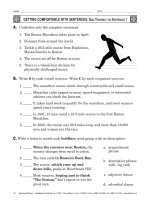Beginning writing 2 part 3
Bạn đang xem bản rút gọn của tài liệu. Xem và tải ngay bản đầy đủ của tài liệu tại đây (167.92 KB, 10 trang )
8
Beginning Writing 2
• Saddleback Publishing, Inc. © 2001 • Three Watson, Irvine, CA 92618 • Phone: (888) 735-2225 • Fax: (888) 734-4010 • www.sdlback.com
NAME DATE
GETTING COMFORTABLE WITH WORDS: R
EVIEW
The sentences below tell a mystery story. After you read each sentence,
follow the directions in parentheses.
1. Lottie enjoyed working with her lab partner, a tall, red-headed girl
named Angie.
(Circle the third letter of the first proper noun.)
2. Lottie and Angie always waved and smiled when they saw each other.
(Circle the first letter of the first verb.)
3. One day Lottie saw Angie in the food court of the shopping mall.
(Circle the first letter of the first preposition.)
4. Lottie waved and smiled, but Angie just stared past her.
(Circle the second letter of the first conjunction.)
5. “Angie!” Lottie shouted, but she received no response.
(Circle the first letter of the first verb.)
6. “Hi!” Lottie shouted again, thinking Angie might not have seen
her in the crowd.
(Circle the second letter of an interjection.)
7. Angie passed by as if Lottie did not exist.
(Circle the third letter of the first verb.)
8. Lottie felt ignored and unhappy.
(Circle the fourth letter of a proper noun.)
9. Eventually, she began to feel angry, too.
(Circle the first letter of the first adverb.)
10. What could explain the strange behavior?
(Circle the third letter of an adjective.)
Now solve the mystery by writing the circled letters on the blanks below.
Answer:
This was Angie’s ___ ___ ___ ___ ___ ___ ___ ___ ___ ___ .
1234 5678910
Saddleback Publishing, Inc. © 2001 • Three Watson, Irvine, CA 92618 • Phone: (888) 735-2225 • Fax: (888) 734-4010 • www.sdlback.com •
Beginning Writing 2
9
NAME DATE
GETTING COMFORTABLE WITH WORDS: Q
UIZ
A.
Complete the sentences with the names of the parts of speech listed in
the box. Use consonants to fill in the blanks. Hint: You will not use all
the words in the box.
interjection adjective adverb common noun
preposition conjunction interjection proper noun
1. A __ __o__e__ __ou__ is a word that names a particular
person, place, or thing.
2. A __o__ __o__ __ou__ is a word that
names any person, place, or thing.
3. A __ __o__ou__ is a noun substitute.
4. A word or phrase that shows surprise or
strong feeling is an i__ __e__ __e__ __io__.
5. A linking word that joins ideas is
called a __o__ __u__ __ __io__.
B.
Circle the word that belongs in each
group. Then name the part of speech.
1. important, handsome,
( gentleman / gentle / gently )
PART
OF
SPEECH
:
____________________
2. over, in, ( sky / above / but )
PART
OF
SPEECH
:
____________________
3. shoe, Chicago, ( song / sing / sank )
PART
OF
SPEECH
:
____________________
4. silently, extremely,
( hurry / speedily / freeway )
PART
OF
SPEECH
:
____________________
5. Oh, Hurrah, ( and / yet / Wow )
PART
OF
SPEECH
:
____________________
6. and, but, ( on / or / tin )
PART
OF
SPEECH
:
____________________
7. they, she, ( Marylou / above / we )
PART
OF
SPEECH
:
____________________
8. ask, are, ( suggest / topic /
underneath )
PART
OF
SPEECH
:
____________________
10
Beginning Writing 2
• Saddleback Publishing, Inc. © 2001 • Three Watson, Irvine, CA 92618 • Phone: (888) 735-2225 • Fax: (888) 734-4010 • www.sdlback.com
NAME DATE
GETTING COMFORTABLE WITH SENTENCES: R
ECOGNIZING
A
S
ENTENCE
Review these important facts about
sentences
.
A sentence: •expresses a complete thought.
•begins with a capital letter and ends with an end mark.
•has a noun or pronoun in its subject and a verb in its predicate.
•can be a statement, question, exclamation, or command.
Seven of the following word groups are
sentences. Three are not. Check each word
group to see if it matches the qualifications
described above. If the word group is a complete
sentence, mark it with an S. At the end of the
sentence, tell whether it is a statement, question,
exclamation, or command. The first one has
been done for you. (If the item is not a sentence,
leave the lines blank.)
1. _____ The Brachiosaurus belonged to a group of
giant dinosaurs. ___________________
2. _____ It roamed North America and Africa ages ago. ___________________
3. _____ What did the Brachiosaurus look like? ___________________
4. _____ More than 75 feet long and 40 feet tall! ___________________
5. _____ Had a huge body. ___________________
6. _____ Its head, however, was quite small. ___________________
7. _____ Scientists once discovered an entire
Brachiosaurus skeleton. ___________________
8. _____ Rebuilt it and put it in a museum. ___________________
9. _____ Museum visitors, don’t touch that skeleton! ___________________
10. _____ Wow! That Brachiosaurus is really huge! ___________________
11. _____ It is the largest animal skeleton ever found
and rebuilt. ___________________
CHALLENGE: On the back of this sheet, write four sentences about an
interesting animal. Write one statement, one question, one exclamation,
and one command. Exchange papers with another student and make
sure your classmate has written complete sentences.
statement
S
Saddleback Publishing, Inc. © 2001 • Three Watson, Irvine, CA 92618 • Phone: (888) 735-2225 • Fax: (888) 734-4010 • www.sdlback.com •
Beginning Writing 2
11
NAME DATE
GETTING COMFORTABLE WITH SENTENCES: W
RITING
A
S
IMPLE
S
ENTENCE
A
simple sentence
has a subject and a predicate. The subject includes a noun
or pronoun and tells who or what the sentence is about. The predicate includes
a verb that either tells what the subject does or expresses its state of being.
EXAMPLES:
My unusual friend eats chocolate-covered worms. Doug is an odd fellow.
A.
Make a complete single sentence by matching each word group in the
first column with a word group in the second column. Draw lines to
show your matches.
1. _____ the lazy cat
2. _____ know the best fishing holes
3. _____ wore a silly red nose
4. _____ the first job applicant
5. _____ the early bird
a. gets the worm
b. waited nervously for
her interview
c. the experienced fishermen
d. purred softly in the sun
e. the circus clown
B.
Each of the following word groups needs either a subject or a predicate
to be a complete simple sentence. Write subject or predicate to show
which sentence part is missing. Then write a complete sentence by
adding your own words. Use correct capitalization and punctuation.
The first one has been done for you.
1. ____________________ the sputtering engine
____________________________________________________________________
2. ____________________ burst through the front door
____________________________________________________________________
3. ____________________ eats tacos in bed
____________________________________________________________________
4. ____________________ is ready for a nap
____________________________________________________________________
5. ____________________ a cold wind from the north
____________________________________________________________________
CHALLENGE: On the back of this sheet, use each of the following
noun-verb pairs to write a complete sentence: parents
/
taught,
job
/
was, stranger
/
disappeared, storm
/
brought, I
/
left.
VERB
➝
NOUN
➝
VERBNOUN
➝
➝
SUBJECT
PREDICATE SUBJECT
PREDICATE
predicate
The sputtering engine coughed and died.
12
Beginning Writing 2
• Saddleback Publishing, Inc. © 2001 • Three Watson, Irvine, CA 92618 • Phone: (888) 735-2225 • Fax: (888) 734-4010 • www.sdlback.com
NAME DATE
GETTING COMFORTABLE WITH SENTENCES: P
REPOSITIONAL
P
HRASES
A
phrase
is a unit of two or more words that cannot stand alone. It is
part of a sentence. A phrase does
not
have both a subject and a predicate.
A
prepositional phrase
always has a preposition and an object (a noun or
pronoun that follows the preposition).
EXAMPLE:
Our antique clock sits
above our fireplace.
A prepositional phrase serves the same function as an adjective or an adverb.
It adds meaning by telling
which one, where, when, how, why,
or
to what extent.
A.
Underline the prepositional phrase in each sentence. Then write which
one, where, when, how, why, or to what extent on each line.
1. ___________________ Justin often takes the bus in the morning.
2. ___________________ He catches it at dawn.
3. ___________________ The city bus stops on the corner.
4. ___________________ It takes him directly to his office.
5. ___________________ He makes the bus trip with several neighbors.
6. ___________________ The bus with air conditioning is their favorite one.
7. ___________________ The riders appreciate relief on hot summer days.
B.
Complete each sentence with a prepositional phrase that adds meaning.
Use some of the following prepositions:
on between with over out above after
in around of about down along through
1. We usually eat dinner ______________________________________________.
2. The coat ___________________________________________________ is mine.
3. Don’t forget to put the cat ___________________________________________.
4. The horse galloped _________________________________________________.
CHALLENGE: On the back of this sheet, write original sentences using the
following prepositional phrases: on the desk, in my dream, with great
excitement, at midnight, with modern features.
OBJECT
➝
➝
PREPOSITION
PREPOSITIONAL PHRASE









